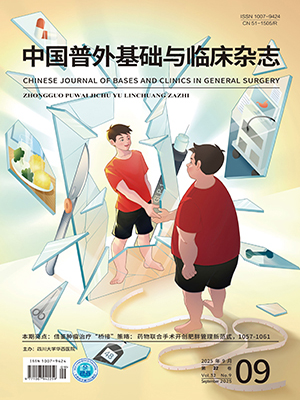| 1. |
Roberts SE, Akbari A, Thorne K, et al. The incidence of acute pancreatitis:impact of social deprivation, alcohol consumption, seasonal and demographic factors. Aliment Pharmacol Ther, 2013, 38(5):539-548.
|
| 2. |
Sah RP, Dawra RK, Saluja AK. New insights into the pathogenesis of pancreatitis. Curr Opin Gastroenterol, 2013, 29(5):523-530.
|
| 3. |
Li ZT, Ma B, Lu M, et al. Construction of network for protein kinases that play a role in acute pancreatitis. Pancreas, 2013, 42(4):607-613.
|
| 4. |
Xu P, Wang J, Yang ZW, et al. Regulatory roles of the PI3K/Akt signaling pathway in rats with severe acute pancreatitis. PLoS One, 2013, 8(11):e81767.
|
| 5. |
Working Party of the British Society of Gastroenterology. Association of surgeons of Great Britain and Ireland; pancreatic society of Great Britain and Ireland; association of upper GI surgeons of Great Britain and Ireland. UK guidelines for the management of acute pancreatitis. Gut, 2005, 54(suppl 3):1-9.
|
| 6. |
徐延鈞, 吳新民, 郭亞民.腫瘤壞死因子-α及白介素在急性胰腺炎中的作用.中國普外基礎與臨床雜志, 2010, 17(9):993-996.
|
| 7. |
石力, 田伏洲, 李旭, 等.急性胰腺炎大鼠肝臟NF-κB對TNF-α表達的調控及其在肝損傷中的作用.中國普外基礎與臨床雜志, 2004, 11(3):228-230.
|
| 8. |
余文, 吳偉, 張少輝, 等.急性胰腺炎發病機理的研究進展.中國普外基礎與臨床雜志, 2006, 13(6):733-736.
|
| 9. |
Sharma B, Srivastava S, Singh N, et al. Role of probiotics on gut permeability and endotoxemia in patients with acute pancreatitis:a double-blind randomized controlled trial. J Clin Gastroenterol, 2011, 45(5):442-448.
|
| 10. |
王峰.異甘草酸鎂在大鼠胰腺炎肝損害治療中的作用.中國藥物與臨床, 2014, 14(2):180-182.
|
| 11. |
Halonen KI, Pettila V, Leppaniemi AK, et al. Multiple organ dysfunction associated with severe acute pancreatitis. Crit Care Med, 2002, 30(6):1274-1279.
|
| 12. |
陳勇, 曾艷凌, 林志輝, 等.早期肝功能損害對急性胰腺炎病因判定的臨床價值.世界華人消化雜志, 2012, 20(34):3390-3393.
|
| 13. |
Laplante M, Sabatini DM. mTOR signaling in growth control and disease. Cell, 2012, 149(2):274-293.
|
| 14. |
Markman B, Dienstmann R, Tabernero J. Targeting the PI3K/Akt/mTOR pathway-beyond rapalogs. Oncotarget, 2010, 1(7):530-543.
|
| 15. |
Zhan YH, Liu J, Qu XJ, et al.β-elemene induces apoptosis in human renal-cell carcinoma 786-0 cells through inhibition of MAPK/ERK and PI3K/Akt/mTOR signalling pathways. Asian Pac J Cancer Prev, 2012, 13(6):2739-2744.
|
| 16. |
Klempner SJ, Myers AP, Li J, et al. Derivation and characterization of endometrial cancer cells resistant to phosphatidylinositol-3-kinase (PI3K) pathway inhibitors. Cancer Res, 2013, 73(8 Supplement):4265.
|
| 17. |
Dienstmann R, Rodon J, Serra V, et al. Picking the point of inhibition:a comparative review of PI3K/AKT/mTOR pathway inhibitors. Mol Cancer Ther, 2014, 13(5):1021-1031.
|
| 18. |
Chen ZH, Yang L, Liu Y, et al. LY294002 and rapamycin promote coxsackievirus-induced cytopathic effect and apoptosis via inhibition of PI3K/AKT/mTOR signaling pathway. Mol Cell Biochem, 2014, 385(1/2):169-177.
|
| 19. |
Fan QW, Weiss WA. Inhibition of PI3K-Akt-mTOR signaling in glioblastoma by mTORC1/2 inhibitors. Methods Mol Biol, 2012, 821:349-359.
|
| 20. |
程飛, 張獻全, 宋孟龍, 等. P13K/Akt/mTOR信號通路參與缺氧誘導因子-1α在急性胰腺炎大鼠的表達調節.中國急救醫學, 2010, 30(4):330-334.
|
| 21. |
Agani F, Jiang BH. Oxygen-independent regulation of HIF-1:novel involvement of PI3K/AKT/mTOR pathway in cancer. Curr Cancer Drug Targets, 2013, 13(3):245-251.
|
| 22. |
Semenza GL. Regulation of oxygen homeostasis by hypoxia-inducible factor 1. Physiology, 2009, 24(2):97-106.
|
| 23. |
Dos Santos S, Delattre AI, De Longueville F, et al. Gene expression profiling of LPS-stimulated murine macrophages and role of the NF-kappaB and PI3K/mTOR signaling pathways. Ann N Y Acad Sci, 2007, 1096(1):70-77.
|
| 24. |
Carden CP, Stewart A, Thavasu P, et al. The association of PI3 kinase signaling and chemoresistance in advanced ovarian cancer. Mol Cancer Therapeu, 2012, 11(7):1609-1617.
|
| 25. |
Cerniglia GJ, Karar J, Tyagi SA, et al. Inhibition of autophagy as a strategy to augment radiosensitization by the dual phosphatidylinositol 3-Kinase/mammalian target of rapamycin inhibitor NVP-BEZ235. Mol Pharmacol, 2012, 82(6):1230-1240.
|
| 26. |
Park KR, Nam D, Yun HM, et al. beta-caryophyllene oxide inhibits growth and induces apoptosis through the suppression of PI3K/AKT/mTOR/S6K1 pathways and ROS-mediated MAPKs activation. Cancer Lett, 2011, 312(2):178-188.
|




